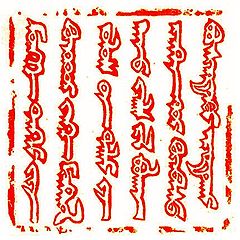- Mongolian script
-
For the traditional alphabet used specifically to write Mongolian, see traditional Mongolian alphabet.
Mongolian 
Type Alphabet Languages Mongolian language
Manchu language (obsolete)
Evenki languageTime period ca.1204 – today Parent systems Proto-Sinaitic alphabetChild systems Manchu alphabet
Oirat alphabet (Clear script)
Buryat alphabet
Galik alphabet
Evenki alphabet
Xibe alphabetISO 15924 Mong, 145 Direction Left-to-right Unicode alias Mongolian Unicode range U+1800 – U+18AF Note: This page may contain IPA phonetic symbols. The classical Mongolian script (in Mongolian script:
 (ᠮᠣᠩᠭᠣᠯ ᠪᠢᠴᠢᠭ᠌) Mongγol bičig; in Mongolian Cyrillic: Монгол бичиг, Mongol bichig), also known as Uyghurjin, was the first writing system created specifically for the Mongolian language, and was the most successful until the introduction of Cyrillic in 1946. Derived from Uighur, Mongolian is a true alphabet, with separate letters for consonants and vowels. The Mongolian script has been adapted to write languages such as Oirat and Manchu. Alphabets based on this classical vertical script are used in Inner Mongolia and other parts of China to this day to write Mongolian, Sibe and, experimentally, Evenki.
(ᠮᠣᠩᠭᠣᠯ ᠪᠢᠴᠢᠭ᠌) Mongγol bičig; in Mongolian Cyrillic: Монгол бичиг, Mongol bichig), also known as Uyghurjin, was the first writing system created specifically for the Mongolian language, and was the most successful until the introduction of Cyrillic in 1946. Derived from Uighur, Mongolian is a true alphabet, with separate letters for consonants and vowels. The Mongolian script has been adapted to write languages such as Oirat and Manchu. Alphabets based on this classical vertical script are used in Inner Mongolia and other parts of China to this day to write Mongolian, Sibe and, experimentally, Evenki.Contents
History
 The Stele of Yisüngge, possibly the oldest surviving monument in Uyghur-Mongolian script, Hermitage Museum, Saint Petersburg, Russia.
The Stele of Yisüngge, possibly the oldest surviving monument in Uyghur-Mongolian script, Hermitage Museum, Saint Petersburg, Russia.
The Mongolian vertical script was developed as an adaptation of the Uyghur script to write the Mongolian language. It was introduced by the Uyghur scribe Tatar-Tonga, who had been captured by the Mongols during a war against the Naimans around 1204. There were no substantive changes to the Uyghur form for the first few centuries, so that, for example, initial yodh stood for both [dʒ] and [j], while medial tsadi stood for both [dʒ] and [tʃ], and there was no letter for [d] in initial position. Mongolian sources often distinguish the early forms by using the term Uyghurjin script Mongolian for Uyghur style script). Western sources tend to use this term as a synonym for all variations of the Mongolian script.[citation needed]
The middle period of the development of Mongolian extended from the seventh and eighth to the fifteenth and sixteenth centuries. The Mongolian language of this period is divided into southern. eastern and western dialects. The principal monuments of the middle period are: in the eastern dialect, the famous Secret History of the Mongols, monuments in the square script, materials of the Chinese-Mongolian glossary of the fourteenth century, and materials of the Mongolian language of the middle period in Chinese transcription, etc.; in the western dialect, materials of the Arab-Mongolian and Persian-Mongolian dictionaries, Mongolian texts in Arabic transcription, etc. The main features of the period are that the vowels ï and i had lost their phonemic significance, creating the i phoneme; intervocal consonants Y/g, b/w had disappeared and the preliminary process of the formation of Mongolian long vowels had begun; the initial h was preserved in many words; grammatical categories were partially absent, etc. The development over this period explains why Mongolian script look like a vertical Arabic script (in particular the presence of the dots system).
Eventually, minor concessions were made to the differences between the Uyghur and Mongol languages: In the 17th and 18th centuries, smoother and more angular versions of tsadi became associated with [dʒ] and [tʃ] respectively, and in the 19th century, the Manchu hooked yodh was adopted for initial [j]. Zain was dropped as it was redundant for [s]. Various schools of orthography, some using diacritics, were developed to avoid ambiguity.
Mongolian is written vertically. The Uyghur script and its descendants—Mongolian, Oirat Clear, Manchu, and Buryat—are the only vertical scripts written from left to right. This developed because the Uyghurs rotated their Sogdian-derived script, originally written right to left, 90 degrees counterclockwise to emulate Chinese writing, but without changing the relative orientation of the letters.[1]
Letters
Letters have different forms depending on their position in a word: initial, medial, or final. In some cases, additional graphic variants are selected for visual harmony with the subsequent character.
Alphabets
The inventory of Mongol letters has been used to as alphabet for at least four languages. First and foremost, after overcoming the Uyghur script ductus, it was used for Mongolian. It was also used in the ancient Manchurian documents before diacritics were added and the Manchu script was derived. Most recently, an experimental alphabet for Evenki was created in the 1980s.
Derived scripts
Clear script (Oirat alphabet)
In 1648, the Oirat Buddhist monk Zaya-pandita Namkhaijamco created this variation with the goals of bringing the written language closer to the actual pronunciation of Oirat and making it easier to transcribe Tibetan and Sanskrit. The script was used by the Kalmyks of Russia until 1924, when it was replaced by the Cyrillic alphabet. In Xinjiang, China, the Oirat people still use it.
Manchu alphabet
The Manchu alphabet was developed from the Mongolian script in the early 17th century to write the Manchu language. A variant is still used to write Xibe. It is also used for Daur.
Buryat alphabet
Another alphabet, sometimes called Vaghintara, was created in 1905 by a Buryat monk named Agvan Dorjiev (1854–1938). It was also meant to reduce ambiguity, and to support the Russian language in addition to Mongolian. The most significant change, however, was the elimination of the positional shape variations. All letters were based on the medial variant of the original Mongol alphabet. After a few years, Agvan-Dorjiev ran out of funds to promote his invention further, so that fewer than a dozen books were printed using it.
Additional characters
Galik characters
Main article: Galik alphabetIn 1587, the translator and scholar Ayuush Güüsh (Аюуш гүүш) created the Galik alphabet (Али-гали), inspired by the third Dalai Lama, Sonam Gyatso. It primarily added extra characters for transcribing Tibetan and Sanskrit terms when translating religious texts, and later also from Chinese. Some of those characters are still in use today for writing foreign names (compare table above).[2]
Unicode
Mongolian script was added to the Unicode Standard in September, 1999 with the release of version 3.0.
Block
The Unicode block for Mongolian is U+1800–U+18AF. It includes letters, digits and various punctuation marks for Hudum Mongolian, Todo Mongolian, Xibe (Manchu), Manchu proper, and Ali Gali, as well as extensions for transcribing Sanskrit and Tibetan.
Mongolian[1]
Unicode.org chart (PDF)0 1 2 3 4 5 6 7 8 9 A B C D E F U+180x ᠀ ᠁ ᠂ ᠃ ᠄ ᠅ ᠆ ᠇ ᠈ ᠉ ᠊ ᠋ ᠌ ᠍ U+181x ᠐ ᠑ ᠒ ᠓ ᠔ ᠕ ᠖ ᠗ ᠘ ᠙ U+182x ᠠ ᠡ ᠢ ᠣ ᠤ ᠥ ᠦ ᠧ ᠨ ᠩ ᠪ ᠫ ᠬ ᠭ ᠮ ᠯ U+183x ᠰ ᠱ ᠲ ᠳ ᠴ ᠵ ᠶ ᠷ ᠸ ᠹ ᠺ ᠻ ᠼ ᠽ ᠾ ᠿ U+184x ᡀ ᡁ ᡂ ᡃ ᡄ ᡅ ᡆ ᡇ ᡈ ᡉ ᡊ ᡋ ᡌ ᡍ ᡎ ᡏ U+185x ᡐ ᡑ ᡒ ᡓ ᡔ ᡕ ᡖ ᡗ ᡘ ᡙ ᡚ ᡛ ᡜ ᡝ ᡞ ᡟ U+186x ᡠ ᡡ ᡢ ᡣ ᡤ ᡥ ᡦ ᡧ ᡨ ᡩ ᡪ ᡫ ᡬ ᡭ ᡮ ᡯ U+187x ᡰ ᡱ ᡲ ᡳ ᡴ ᡵ ᡶ ᡷ U+188x ᢀ ᢁ ᢂ ᢃ ᢄ ᢅ ᢆ ᢇ ᢈ ᢉ ᢊ ᢋ ᢌ ᢍ ᢎ ᢏ U+189x ᢐ ᢑ ᢒ ᢓ ᢔ ᢕ ᢖ ᢗ ᢘ ᢙ ᢚ ᢛ ᢜ ᢝ ᢞ ᢟ U+18Ax ᢠ ᢡ ᢢ ᢣ ᢤ ᢥ ᢦ ᢧ ᢨ ᢩ ᢪ Notes - 1.^ As of Unicode version 6.0
Issues
Although the Mongolian script has been defined in Unicode since 1999, there was no support for Unicode Mongolian from the major vendors until the release of the Windows Vista operating system in 2007, and so Unicode Mongolian is not yet widely used. In China, legacy encodings such as the Private Use Area (PUA) Unicode mappings and GB18030 mappings of the Menksoft IMEs (espc. Menksoft Mongolian IME) are more commonly used than Unicode for writing web pages and electronic documents in Mongolian.
The inclusion of a Unicode Mongolian font and keyboard layout in Windows Vista has meant that Unicode Mongolian is now gradually becoming more popular, but the complexity of the Unicode Mongolian encoding model and the lack of a clear definition for the use variation selectors are still barriers to its widespread adoption, as is the lack of support for inline vertical display. Currently there are no fonts that successfully display all of Mongolian when written in Unicode[citation needed]. A report published in 2011 revealed many shortcomings with automatic rendering in all three Unicode Mongolian fonts the authors surveyed, including Microsoft's Mongolian Baiti[3].
Furthermore, Mongolian language support has suffered from buggy implementations: the initial version of Microsoft's Mongolian Baiti font was, in the supplier's own words, "almost unusable"[4], and as of 2011 there remain some serious bugs with the rendering of suffixes in Mozilla Firefox[5].
References
- ^ György Kara, "Aramaic Scripts for Altaic Languages", in Daniels & Bright The World's Writing Systems, 1994.
- ^ Otgonbayar Chuluunbaatar (2008) (in German). Einführung in die Mongolischen Schriften. Buske. ISBN 978-3-87548-500-4.
- ^ Biligsaikhan Batjargal, et al. (2011). "A Study of Traditional Mongolian Script Encodings and Rendering: Use of Unicode in OpenType fonts". International Journal of Asian Language Processing 21 (1): 23-43. http://www.colips.org/journal/volume21/21.1.3-Biligsaikhan.pdf. Retrieved 2011-09-10.
- ^ Version 5.00 of the Mongolian Baiti font may be displayed incorrectly in Windows Vista
- ^ Bug 490534 - ZWJ and NNBSP rendered incorrectly in scripts like Mongolian
External links
- Sample text of Uyghurjin script - printing ()
- Sample text of Uyghurjin script - handwriting (cursive)
- Omniglot: Mongolian Alphabet
- The Silver Horde: Mongol Scripts
Inner Mongolia topics Hohhot (capital) General Geography Education Culture Music of Mongolia • Mongolian language • Mongolian script • Northeastern Mandarin • Plain Blue BannerCuisine Visitor attractions Categories:- Classical Mongolian alphabet
- Alphabetic writing systems
- Mongolian writing systems
- 1.^ As of Unicode version 6.0
Wikimedia Foundation. 2010.



